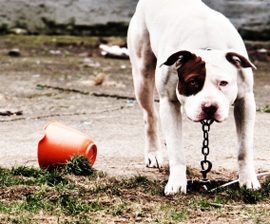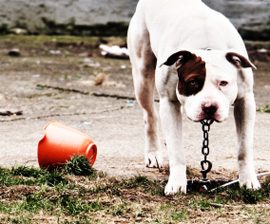

End of the Rope
I read a story the other
day about a dog named Rocky, who’d been chained out in his yard in
Enumclaw, Washington for fourteen years. His world consisted of a forty foot-wide circle of mud and dung, with a plastic dog house and a bucket of water. All year- rain, shine, snow, you name it. For years, neighbors complained, to no avail. Apparently the law states that, as long as a dog has shelter and water, nothing can be done.
Luckily, authorities
eventually got the owner to surrender him; Rocky got to live out the
remainder of his short life in comfort, though I’m guessing that he
probably spent the rest of his days trying to figure out just what
"comfort" really meant.
There are times when
tethering a dog can be a legitimate training technique, particularly
indoors, to get it to calm down, focus, and learn to observe without
thinking it has to participate in every event. It allows an untrained dog to settle and feel part of the goings on, without being a burden to others. Fear-aggressive
pets tethered to a doorknob (with someone present) can also benefit
from seeing that other dogs or people relaxing close by are in fact of
no danger to them.
Observed
outdoor tethering can accomplish the same thing, provided it is used on a
temporary basis, for the reasons stated above. But it should only be used to further some training objective, and never as a permanent "containment" solution.
Unfortunately,
many people still resort to tethering dogs outdoors, often for years at
a time, for various reasons, all of them misguided. Some owners do not have their yards properly fenced, and reason that a twenty foot chain is cheaper than a new enclosure. Or, the fence available simply is not secure enough to hold the dog.
The majority of those who
tether feel that the dog, for whatever reason, does not belong inside
for much of the day, or at all in some cases. The owner might be gone too many hours of the day for the dog to be left inside without eliminating. Perhaps the dog has never been properly trained, and would otherwise be destructive indoors. The dog could have other behavioral issues that make indoor housing problematic. Or, it’s just not hygienic enough to be kept inside.
Physically, chaining can be extremely damaging to a dog, who can get tangled up, resulting in damaged limbs. Or,
a young dog chained up will invariably outgrow the collar (often also a
chain), which digs into the neck, often strangling the pet. The dog
can also hang itself in an attempt to jump a fence.
From a behavioral standpoint, chaining a dog is one of most efficient ways to screw it up. It limits a dog’s territory to a finite circle, which short-circuits a dog’s "fight-or-flight" instinct. If a dog feels its mobility limited in any way, it can become anxious, resulting in hostility. It’s why dog-on-dog aggression is so much more prevalent on-leash than off-leash.
The constant tug of the chain acts as an annoying irritant, again leading to aggression. One
of the ways protection trainers encourage dogs to actually "fire up" on
a perpetrator is to restrain the dog on leash, near the point of
contact, then tug it back while using verbal cues to encourage a
defensive, contentious mindset in the dog’s head. A dog
chained in a backyard, upon seeing someone walking by, will go to the
end of its chain, feel the irritating yank, and associate it with the
appearance of the person on the periphery. Gradually, the dog is self-conditioned to believe that all strangers cause the annoying "correction," and are therefore bad.
Chaining a dog also encourages a neurotic mindset. Look
at most yards containing a chained dog and you’ll find a circled path
worn deep down into the dirt or grass, suggesting that the dog spends
much of its time pacing the perimeter, patrolling, worrying, and
searching for stimuli. It’s a classic recipe for OCD. So
many chained dogs whom I have trained have had this neurotic inability
to sit still and focus; it’s deplorable, and preventable.
Part of the problem is plain ignorance. Someone who wants a dog, but has neither the time nor the ability to train, defaults to chaining. Or, someone in the home deplores the hair, the smell, or the chaos inherent to an untrained dog. And so it ends up outside, relegated to being less of a family pet, and more of a security alarm. The irony is that, in order to properly protect a home, a dog needs to be inside the home, and not outside on a chain.
Solutions? First, don’t get a dog unless you have the time and the space to properly care for it. Gone ten hours a day? Get a cat. Next, housetrain your dog properly, so that it doesn’t need to be sequestered in a yard all day. Crate train, and set a consistent routine. Then, train the heck out of your dog, to create confidence, and focus. Socialize as much as possible, and make the yard a fun place to hang out or play. And,
get your dog into the home as much as possible, to create a sense of
belonging, to utilize the dog as an effective intruder alert, and to
remove the pet from an outdoor, restricted environment where anyone seen
is thought of as a potential threat.
Join the newsletter and never miss out on dog content again!
"*" indicates required fields
By clicking the arrow, you agree to our web Terms of Use and Privacy & Cookie Policy. Easy unsubscribe links are provided in every email.